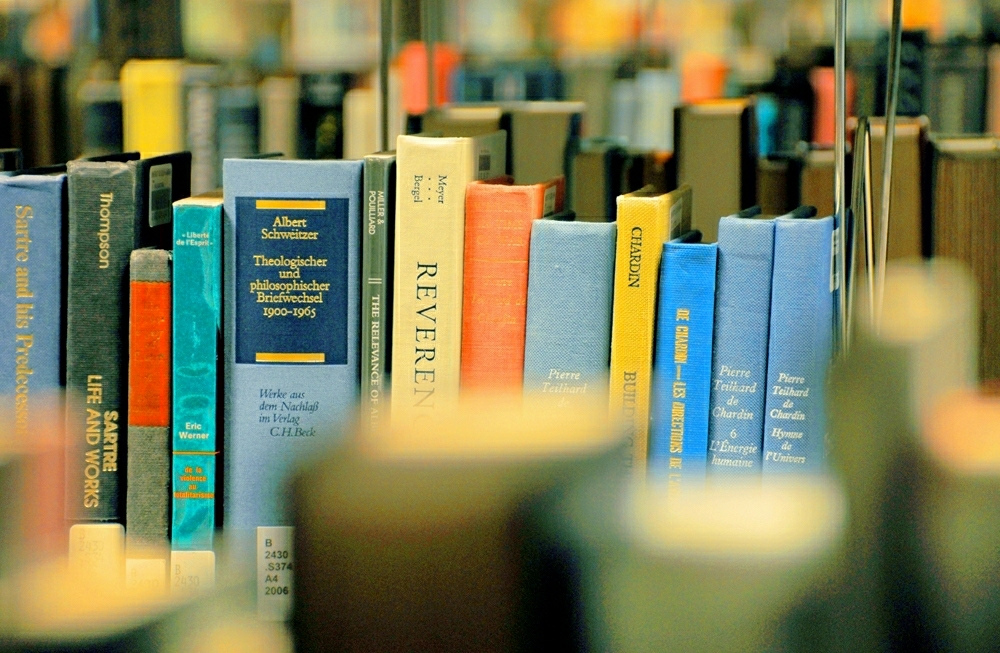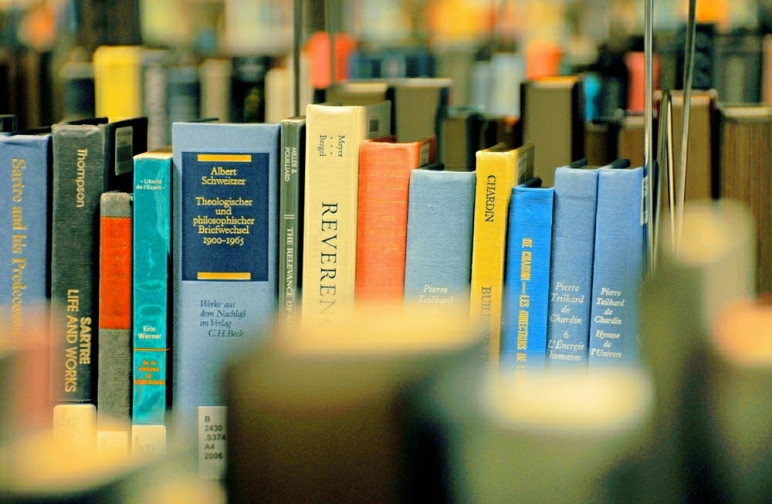The best books of 2015, selected by Sightline staff. Happy reading!
Alan

The Immortal Life of Henrietta Lacks by Myles Grant used under CC BY-NC-SA 2.0
THE IMMORTAL LIFE OF HENRIETTA LACKS
By Rebecca Skloot
ABRAHAM LINCOLN: THE PRAIRIE YEARS AND THE WAR YEARS
By Carl Sandburg
My favorite books this year were Rebecca Skloot’s The Immortal Life of Henrietta Lacks, an extraordinary work of science writing that I’m five years late in reading, and the classic Abraham Lincoln biography of Carl Sandburg, in its condensed audiobook format (still 44 hours), which kept me rapt through months of marathon training. I grew up with the multivolume version of the Sandburg Lincoln peering down on me from my parents’ shelves, but I never read it. The audio version, like running my first and only marathon, were perfect life markers for my fiftieth year—all three now completed. Lincoln was such a fascinating leader—patient, canny, visionary, and a master of timing—and Sandburg such a captivating storyteller—a double Pullitzer-winning poet who loved Lincoln’s use of words as much as his use of the other tools of power. Perhaps it is my own obsession with words that draws me repeatedly to Lincoln, the greatest wordsmith among American leaders. It’s also why I have devoured so many hundreds of pages on Churchill, arguably England’s Lincoln.
Serena
FATES AND FURIES
By Lauren Groff
EUPHORIA
By Lily King
THE WAKE
By Paul Kingsnorth
I’m a big short fiction and essay reader, but if you’re asking books, I (and about a jillion other people, considering its bestseller status) dove headlong into Lauren Groff’s Fates and Furies. It was masterfully rich in its details, and I could recommend it for that quality alone. Her descriptions captured the complex sensations and comparisons she wrote about with a preciseness that made me “ahaaaaa” with each one, as if she had finally succeeded in verbalizing something I’d been thinking about myself for years, wondering how to accurately relay to others. To say nothing of all of the classics references (full disclosure: I was a member of my high school Latin Team… yep! fact!), the interesting bifurcation of the narrative and perspective, and the marriage that comprises the story, a marriage into which we get a uniquely intimate view and which, for me at least, posed fascinating questions about the nature of such a profound relationship and its transformation of the participating individuals.
Less well known but also wonderful was Lily King’s Euphoria, an engrossing novel about three 1920s anthropologists in New Guinea. And I attempted (but didn’t manage to finish before it was due back to the library) Paul Kingsnorth’s The Wake, for which the author uses a curious but surprisingly readable Old English-like language to tell the story of a man enduring the Norman invasion of England in 1066.
Kristin
For reading aloud to a child:
THREE TALES OF MY FATHER’S DRAGON
By Ruth Stiles Gannett
Fiction:

Love 2.0 by Joyce Seitzinger used under CC BY-NC-ND 2.0
SERAPHINA
By Rachel Hartman
SHADOW SCALE
By Rachel Hartman
Nonfiction:
LOVE 2.0
By Barbara L Fredrickson
WITH LIBERTY & DIVIDENDS FOR ALL
By Peter Barnes
Keiko
AMERICANAH
By Chimamanda Ngozi Adichie
BETWEEN THE WORLD AND ME
By Ta-Nehisi Coates
What’s the difference between an African-American and an American-African? Chimamanda Ngozi Adichie explores this question in her latest book Americanah. Adichie tells the story of a young Nigerian woman, Ifemelu, who has emigrated to America and is navigating through life as a person of color in the United States. Adichie’s keen observations of structural inequality in America, and compelling remarks on race, class, and gender oppression, come from her own experiences as a black African in America who has emigrated from Nigeria. Here’s a quote from the witty and strong main character, Ifemelu: “I came from a country where race was not an issue, I did not think of myself as black and I only became black when I came to America.”
And of course, Ta-Nehisi Coates’ bestseller Between the World and Me is a must-read. Written as a letter to his 15-year-old son, Coates describes what it’s like to grow up as African-American in a country built on the “destruction of black bodies.” This slim book is a page-turner; Coates’ shrewd understanding of racial justice in America is eye-opening.

Americanah by Vanderfrog used under CC BY 2.0
Tarika
LONG HIDDEN: SPECULATIVE FICTION FROM THE MARGINS OF HISTORY
By: 27 authors
My recommendation is Long Hidden: Speculative Fiction from the Margins of History. This anthology includes 27 stories based on historical events that took place between 1400 and the early 1900s, and each has an element of speculative fiction (the genre includes science fiction, fantasy, and horror). Instead of focusing on those whom history has favored, the stories focus on people who were relegated to the margins of history, such as enslaved people, indigenous people, people of color, queer people, and/or laborers. The book was made possible by a Kickstarter and was published in 2014, but I had a tall stack of books to read at the time I purchased it, so it goes on my 2015 list.
Margaret
This year I have loved using my local Little Free Libraries—eclectic selection and no library fines! And, after moving from a town with just 3 of these libraries to Seattle, where there are well over 200, I am relishing the bigger selection. Here are a few books that have really stuck with me this year:
Kids’ Books:

The Power of Habit by BubbleTea used under CC BY-NC-SA 2.0
Buenas Noches Gorila
By Peggy Rathmann
Fiction:
Flight Behavior
By Barbara Kingsolver
A Prayer for Owen Meany
By John Irving
Nonfiction:
The Power of Habit
By Charles Duhigg
The Big Necessity
By Rose George
Pam
THE CIRCUMFERENCE OF HOME: ONE MAN’S YEARLONG QUEST FOR A RADICALLY LOCAL LIFE
By Kurt Hoelting
So much of what Kurt writes about speaks to me: going car-free for a year, traveling (by bike, by foot, by kayak) close to “nature,” meditation, and finding previously ignored adventures close to home. It’s well-written. It’s inspiring. It has me thinking about biking to Rainier and hiking the Wonderland. His impetus to spend a year within 100 km of his home on Whidbey Island, without getting in a car, was the climate crisis and how our need to change our lifestyles could be the opportunity for rich adventure.
The Lost Cyclist: The Epic Tale of an American Adventurer and his Mysterious Disappearance
By David Herlihy

Bike Touring by AIS used under CC BY-NC-ND 2.0
Bike history! I love stories of long-ago riding. This wasn’t the best read, but it had enough interesting tidbits for me to give it some kudos. The book describes the true tale of Frank Lenz who attempted to bicycle around the world…in 1892. He didn’t make it. He disappeared in Turkey, likely killed or maybe drowned in a swollen river. William Sachtleben, another cyclist who had been on a world bike tour just prior to Lenz, eventually went off in search of Lenz. It’s a gripping story, though I wasn’t gripped so much by the book.
The history was the best part of the book. Riding around the world now is a big enough adventure. Doing so when bicycles and world travel were still very rare (though booming in the US) is rather impressive. Sachtleben and his buddy Allen traveled (by bike) across China, “a monumental achievement unheard of since the distant days of Marco Polo.” The rarity didn’t inhibit early cyclists’ mileage though. Lenz was covering 60 miles a day for his first month on the road in the United States. In 1893, one of Lenz’s riding buddies biked 10,000 miles, including 216 miles within 24 hours.
I hadn’t realized how the history of recreational bicycling taints its image even today. Early cyclists were “predominantly eastern elitists…[with] prestigious professions.” And the vast majority were men. “Asian cyclists on the West Coast were often harassed, and blacks were formally disbarred from the League of American Wheelmen in 1895.” Bikes were expensive (and heavy)! An “entry-level” ride weighed 45 pounds and cost $125, about a tenth of Lenz’s salary.
Alicia
THE WIND-UP BIRD CHRONICLE
By Haruki Murakami
KNOTS
By R.D. Laing











John Abbotts
Hello,
As an occasional contributor to Sightline blogs, hope I can add one that I received as a holiday present: Now out in paperback, Naomi Klein’s This Changes Everything: Capitalism vs. The Climate. I have read parts of her book on line, including her concluding words,
“History knocked… but did you answer?
That’s a good question, for all of us.”
I will make a New Year’s resolution to read the rest of the book.
And if I can add a suggestion for Weekend Reading 2016, I am watching the news now, and see coverage of the fossil fuel industry’s climate cover-up, along with a peoples’ trial of Exxon during the Paris Climate summit, accessible under today’s (12/31/15) news at http://www.democracynow.org/
I wish a Happy New Year to all at Sightline, and all their supporters.
Liz Banse
Add All the Light We Cannot See to your books list. A masterpiece!
Keiko Budech
Yes, Liz! I second your recommendation. That book is quite a masterpiece. Thank you for reminding us!
John Abbotts
Oh yes, , if I can tag on another comment, it was on the table in the house of my brother and sister-in-law, and comes with their recommendation.
Scott Walker
One of the best reads about our home is “This Place on Earth”. Even though it’s nearly 20 years old, it’s still relevant. Written by some guy named Alan Durning, it’s the love story of our home.
Car-Free Lady
Synchronizing with Kristin’s recommendation, as well as exercising my vagus nerve :-), here’s a good review of “Love 2.0,” including an attached video for the bigger picture.
http://greatergood.berkeley.edu/article/item/the_love_upgrade
Enjoy!